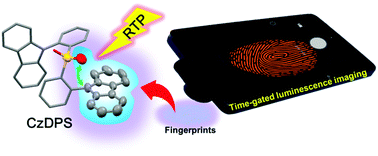Intramolecular electronic coupling for persistent room-temperature luminescence for smartphone based time-gated fingerprint detection†
Abstract
It is desirable to develop pure organic molecules with persistent room temperature luminescence for time-resolved imaging on low-cost instruments. However, the persistent luminescence of many organic molecules is usually observed only in the crystalline state, limiting their broad range of applications in composites with low doping concentrations. Herein, we demonstrate a facile strategy to generate an emitter with long-lived luminescence in both crystalline and amorphous states. By utilizing intramolecular electronic coupling, CzDPS [9-9′-(sulfonylbis(2,1-phenylene))bis(9H-carbazole)] was designed and synthesized, which could emit persistent luminescence in crosslinked polymers with a doping concentration of only 1 wt%. Moreover, the ultra-long persistent luminescence of its powder crystals enables its use in time-resolved luminescence imaging of fingerprints by only using a smartphone under a UV LED. Notably, the interference from fluorescent substrates could be eliminated by photographing after turning off the light. This finding provides a new and facile strategy for forensic investigation of fingerprints which suffers from interference from the scattering and fluorescence signals of substrates.



 Please wait while we load your content...
Please wait while we load your content...